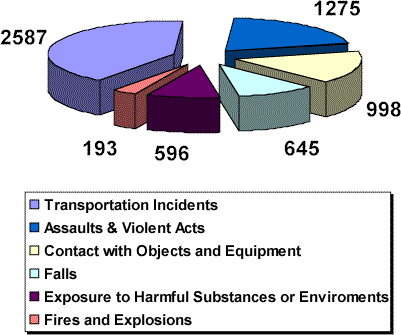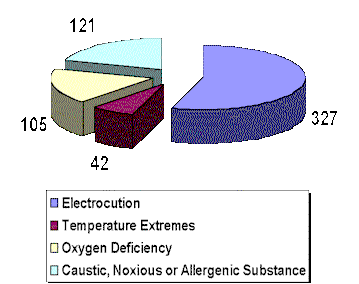I. Occupational Hazards and Diseases
Counting Occupational Diseases: the Tip of an Iceberg
National statistics show that occupational diseases are reported infrequently relative to the number of
traumatic fatalities and musculoskeletal injuries. An occupational illness (or disease) is defined by OSHA as, "any abnormal condition or disorder, other than one resulting from an occupational injury, caused by exposure to factors associated with employment." For several reasons, occupational diseases, as opposed to occupational injuries, are difficult to recognize. Occupational diseases are the "icebergs" that challenge occupational health and safety professionals. Beneath the surface are hidden a large number of occupational diseases that are not recognized or not reported. The number of cases of occupational illness reported for statistical surveys are just the tip of the iceberg.
Like collisions with icebergs, occupational hazards must be recognized before they can be prevented. The graphs below are based on statistics from the Bureau of Labor Statistics (BLS). They depict what we know about recognized and reported occupational fatalities, injuries and illnesses in the population of 126 million working Americans.
II. Reported Fatal Injuries and Illnesses
Average Annual Number of Fatal Occupational Injuries
|
Reference from BLS: Fatal occupational injuries by event or exposure, 1992-97
The previous graph showed that of the 6331 work-related fatalities/year in the United States, 596 are caused by exposure to harmful substances or environments. The next graph details the fatalities caused by these exposures.
Fatalities from Exposure to Harmful Substances or Environments
|
| Of the 327 electrocutions, 128 were caused by contact with overhead power lines; | |
| Of the 42 deaths from temperature extremes, 30 were due to heatstroke and 8 to burns from hot water or steam; | |
| Of the 105 fatalities from oxygen deficiency, 81 were caused by drowning and 10 by methane gas emitted from sewer pits or sewers. | |
| Of the 121 deaths from exposure to caustic, noxious or allergenic substance, 4 workers per year died after bee stings and 35 succumbed after inhalation of a substance (10 after inhalation of carbon monoxide); |
Some of the details above were found in "Perils in the Workplace" from the BLS site.
![]()
III. Reported Nonfatal Injuries and Illnesses
1.8 Million Injuries/Illnesses Required Days Away from Workwith or without Restricted Work Activity:
|
Among the 123,190 systemic diseases involving days away from work reported in 1996 are the following specific conditions:
| Diseases of the blood and blood forming organs--16 | |
| Inflammatory diseases of the central nervous system-- 54 | |
| Carpal tunnel syndrome-- 29,937 | |
| Toxic polyneuropathy-- 240 | |
| Welder's flash--5,109 | |
| Allergic rhinitis--51 | |
| Pneumonia-- 46 | |
| Legionnaires' disease--17 | |
| Extrinsic asthma-- 403 | |
| Pneumoconiosis-- 45 | |
| Dermatitis-- 6,884 |
Reference from BLS: Detailed nature by major industry division--case count 1996
![]()
There were 5.8 million injuries and illnesses that resulted in either lost work time, medical treatment other than first aid, loss of consciousness, restriction of work or motion or transfer to another job.
Of the 5.8 Million Cases Reported in 1996, 439,002 Were Illnesses:
|
Reference from BLS: Total work-related illnesses by category of illness, 1992-96
![]()
IV. Estimating the Size of the Iceberg
Difficulty Counting Work-Related Cancers and Other Long-Term Latent Illnesses
The BLS workplace fatality statistics are obtained by "cross-referencing source documents, such as death certificates, workers' compensation records, and reports to federal and state agencies. This method assures counts are as complete as possible." For work-related illness cases, "Some conditions, e.g., long-term latent illnesses caused by exposure to carcinogens, often are difficult to relate to the workplace and are not adequately recognized and reported. These long-term latent illnesses are believed to be understated in the survey's illness measures."
An Effort to Estimate these Illnesses and Account for other Deficiencies of the BLS System
The following table summarizes the methods and results a scientific paper entitled "Occupational Injury and Illness in the United States: Estimates of Costs, Morbidity, and Mortality." The authors reviewed the national statistics from available sources and applied an attributable risk proportion method in which a certain percentage of the total number of fatalities and illnesses in the U.S. is attributed to occupation based on a "best guess." The assumption made in attributing proportion to cardiovascular (angina and heart attack) and cerebrovascular (stroke) is particularly interesting: "The estimate of 5% to 10% of cardiovascular and cerebrovascular disease is based on a number of studies showing that job strain or psychosocial stress causes excess morbidity and mortality and that selected common chemical exposures, such as lead, carbon monoxide, and solvents, adversely affect the heart."
Occupational Injury and Illness in the United States:Estimates of Costs, Morbidity, and MortalityLeigh JP et al. Arch Intern Med. Vol 157, July 28, 1997, p. 1557-1568 |
|||
| BLS | Leigh, et al. | Method Used to Adjust Annual Incidence | |
| Job-Related Deaths | 6331 | 6500 | |
| Deaths from Disease | 60,300 | Used these proportions of deaths attributable to occupation: 6% to 10 % of cancer; 5% to 10 % of cardiovascular and cerebrovascular disease; 10% of chronic respiratory disease; 100% of pneumoconioses; and 1% to 3% of nervous system disorders and renal disorders; |
|
| Nonfatal Injuries | 6.2 million | 13.2 million | Included government employees; assumed an undercounting in the BLS Annual Survey due to economic incentive; |
| Illnesses | 439,002 | 862,200 | Included illnesses from the BLS Annual Survey (457,400 in 1992) + government employees (92,010) + these proportions of incident cases attributable to occupation: 6% to 10% of cancer, 5% to 10% of coronary heart disease, 5% to 10% of cerebrovascular disease and 10% of chronic obstructive pulmonary disease; |
See PubMed abstracts on injury and illness statistics.
Revised May 30, 2018



